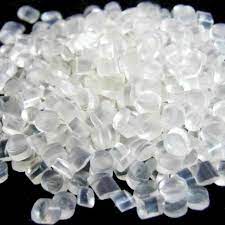
The addition of calcium carbonate plays a skeleton role in plastic products, which has a great effect on the stability of the size of plastic products. For large blow molding products, it can speed up product molding and shorten the product molding cycle.
In plastics, especially soft polyvinyl chloride, the hardness gradually increases with the addition of calcium carbonate, and the elongation decreases with the increase of hardness. Calcium carbonate with fine particles and high oil absorption value has a large increase in hardness. Conversely, calcium carbonate with a small coarse oil absorption value will have a small increase in the hardness of the plastic. In soft PVC, the hardness growth rate of heavy calcium carbonate is the smallest, followed by precipitated calcium carbonate (light calcium).
Calcium carbonate generally cannot play a reinforcing role in plastic (resin), and the particles of calcium carbonate can often be infiltrated by resin, so the normal effect of adding calcium carbonate is to increase the rigidity of the resin, and also increase the elastic modulus and hardness. Both the rigidity strength and elongation decrease with the increase of the addition amount.
Different calcium carbonate, different addition amount, hardness will also be different.
The addition of calcium carbonate can change the rheological properties of plastics. Calcium carbonate powder is often added in a relatively large amount, which is helpful for its mixing with other components and also for the processing and forming of plastics.
The addition of calcium carbonate, especially after the addition of surface-treated calcium carbonate, can not only improve the hardness of the product, but also improve the surface gloss and surface smoothness of the product.
The addition of calcium carbonate can reduce the shrinkage rate, linear expansion coefficient and creep performance of plastic products, creating conditions for processing and forming.
Adding calcium carbonate to general plastic products can improve their heat resistance. For example: in polypropylene, adding about 40% of calcium carbonate, the heat resistance is increased by about 200°C; ‘when the filling ratio is ≤20%, the heat resistance temperature is increased by 8-130°C.
In plastic products, some products require whitening and opacity, and some products require matting. The addition of calcium carbonate can play a certain role in this respect.
Calcium carbonate with whiteness above 90 has obvious whitening effect in plastic products. Combined with titanium dioxide and lithopone, the matting properties of plastic products are greatly improved.
In calcium-plastic paper, low-density polyethylene (LDPE) and high-density polyethylene (HDPE) films, adding calcium carbonate can achieve astigmatism and extinction, making it suitable for writing and printing.
Calcium carbonate with better whiteness can also replace expensive white pigments.
The addition of calcium carbonate to the cable material has a certain insulating effect, and the addition of calcium carbonate can improve the electroplating performance and printing performance of some products.
Fine or ultrafine calcium carbonate is added to polyvinyl chloride (PVC), which has a certain flame retardant effect.
The price of ordinary light calcium carbonate and heavy calcium carbonate is far lower than the price of plastic, and the addition of calcium carbonate will reduce the cost of plastic products.
At this stage, the main goal is to add calcium carbonate to reduce the cost of plastics. With the improvement of calcium carbonate surface properties and controllable shape and particle size, calcium carbonate will gradually become a functional filler for the purpose of reinforcement or imparting functionality.
Calcium carbonate is the most commonly used filler in the production and processing of PVC products. Most of its purpose is to increase the amount of PVC products and reduce production costs.
